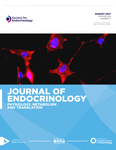Exogenous thyroxine improves glucose intolerance in insulin-resistant rats
- Guillermo Vazquez-Anaya1⇑,
- Bridget Martinez1,
- José G Soñanez-Organis2,
- Daisuke Nakano3,
- Akira Nishiyama3 and
- Rudy M Ortiz1
- 1Department of Molecular & Cellular Biology, University of California, Merced, California, USA
- 2Division of Science and Engineering, Department of Chemical Biological and Agropecuary Sciences, University of Sonora, Navojoa, Sonora, Mexico
- 3Department of Pharmacology, Faculty of Medicine, Kagawa University, Kagawa, Japan
- Correspondence should be addressed to G Vazquez-Anaya; Email: Gvazquez-anaya{at}ucmerced.edu
-
Figure 6
Mean (±s.e.) percent change from LETO for the ratios of (A) p-INS to INS (B) p-AMPK to AMPK including representative Western blot bands and (C) mean fold-change of mRNA expression relative to LETO for Glut4 in soleus muscle of LETO, OLETF and OLETF + T4 after 5-week treatment. #P < 0.05 vs OLETF.
- © 2017 Society for Endocrinology











